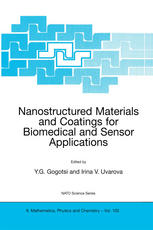

Most ebook files are in PDF format, so you can easily read them using various software such as Foxit Reader or directly on the Google Chrome browser.
Some ebook files are released by publishers in other formats such as .awz, .mobi, .epub, .fb2, etc. You may need to install specific software to read these formats on mobile/PC, such as Calibre.
Please read the tutorial at this link: https://ebookbell.com/faq
We offer FREE conversion to the popular formats you request; however, this may take some time. Therefore, right after payment, please email us, and we will try to provide the service as quickly as possible.
For some exceptional file formats or broken links (if any), please refrain from opening any disputes. Instead, email us first, and we will try to assist within a maximum of 6 hours.
EbookBell Team

4.1
20 reviewsThis volume contains papers that were presented at the NATO Advanced Research Workshop on Nanostructured Materials and Coatings for Biomedical and Sensor Applications held in Kyiv, Ukraine, 4-8 August, 2002. A total of 104 scientists from 14 countries participated in our ARW, making it a really international event. Participants ranged from graduate students to senior researchers. They presented 16 tutorial lectures, 20 short talks and more than 70 posters. Invited speakers, from NATO and Partner countries, presented some of the most recent developments in physics, chemistry and technology of nanosized materials. A broad range of speakers having international standing and representing NATO and partner countries, as well as university, industrial and govemment research laboratories participated in this meeting and wrote papers for this volume. Foregoing ARW gathered together the scientists working in the area of nanosized materials and coatings and their applications in biomedicine and sensors. The first objective of this AR W was to discuss the current research covering a wide range of physical and chemical properties of biomaterials and their use. Active discussion of oral presentations and posters, and the round table discussion gave a good opportunity to researchers from academia and industry to discuss the achievements in this field and outline future directions in terms of technological developments and product commercialisation in the fields of biomedicine and sensors. Particularly, advanced ceramics and nanostructured carbons were covered in many presentations.